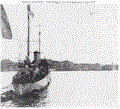Click On Image
For Full Size Image |
Size |
Image Description |
Contributed
By And/Or Copyright |
 |
67k | Rear Admiral Francis H. Gregory was born in Norwalk, Conn., 9 October 1780. While in the merchant service, he was impressed by the British in an incident typical of those which led in part to the War of 1812. After escaping, Gregory was appointed a midshipman 16 January 1809 by President Jefferson and reported to Revenge, commanded by Oliver Hazard Perry. In March 1809 he was transferred to the Gulf Squadron at New Orleans. While serving in Vesuvius and as captain of Gun Boat 162, Gregory participated in the capture of an English brig smuggling slaves into New Orleans and three Spanish pirate ships. During the War of 1812, he served on Lake Ontario under Commodore Isaac Chauncey and participated in attacks on Toronto, Kingston, and Fort George. In August 1814 Gregory was captured by the British; refused parole, he was sent to England and remained there until June 1815. After he was released by the British, Gregory joined the Mediterranean Squadron and operated along the North African coast until 1821. In that year he became captain of Grampus and spent the following 2 years cruising the West Indies, to suppress piracy. While in the Indies. Gregory captured the notorious pirate brig Panchita and destroyed several other pirate ships. After fitting out, the frigate Brandywine, destined to carry LaFayette back to France, in 1824, Gregory sailed a 64 gun frigate to Greece for the revolutionary government. From 1824-1828 he served at the New York Navy Yard, and in 1831 reported to the Pacific Station for a 3-year cruise in command of Falmouth. Gregory served as commander of the Station for 1 year. From the Pacific, Gregory—appointed a Captain in 1838—sailed to the Gulf of Mexico, where he commanded North Carolina and Raritan and served in the blockade of the Mexican coast during the war with that country. After the Mexican War, Gregory commanded the squadron off the African coast, with Portsmouth as his flagship, until June 1851. Returning to the States, he became Commandant of the Boston Navy Yard in May 1852 and served there through February 1856. His subsequent retirement ended a navy career which spanned nearly 50 years. When the bloody Civil War rolled across the land, Gregory returned to naval service to superintend the building and fitting out of naval vessels in private shipyards. Promoted to Rear Admiral 16 July 1862, he served throughout the 4 years of war and then retired again. Admiral Gregory died 4 October 1866 in Brooklyn, and was buried at New Haven, Conn. | Bill Gonyo |
 |
75k | Undated, location unknown. | Curt Clark, The Four Stack APD Veterans |
 |
79k | Undated, at Cattaro. | Frank Hoak III, Captain US Navy retired |
 |
270k | Bethlehem Shipbuilding Corporation, Fore River Shipyard, Quincy, Massachusetts, 1918. Shown: Hull 274 (USS Little), Hull 275 (USS Kimberley), Hull 276 (USS Sigourney), Hull 277 (USS Gregory), Hull 280 (USS Colhoun), Hull 281 (USS Stevens). Secretary of the Navy Josephus Daniels Collection. Courtesy of the Library of Congress. | Mike Mohl |
 |
178k | Fore River Shipbuilding Company, Quincy, Massachusetts. Ships fitting out at the Fore River shipyard, 19 March 1918. The six destroyers are Little (DD-79), Kimberly (DD-80), Sigourney (DD-81), Gregory (DD-82), Colhoun (DD-85) and Stevens (DD-86), which had builder's hull numbers 274-277 and 280-281 respectively. The freighter at right is Katrina Luckenbach, yard hull # 267, which served as USS Katrina Luckenbach in 1918-19. Most of the equipment on the pier is for her. Note the large submarine being built in the background, under the revolving crane. U.S. Naval Historical Center Photograph. | Fred Weiss |
 |
56k | USS Gregory (DD-82) in a European port, circa 1919. Note single-engine seaplane flying overhead. U.S. Naval Historical Center Photograph. | Fred Weiss |

| 147k | Map of Iron Bottom Sound indicating where ships were sunk during the Battle of Guadacanal. | Ron Reeves |


 11 of her crew were lost and remain on duty.
11 of her crew were lost and remain on duty.